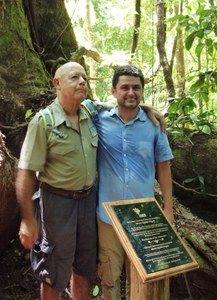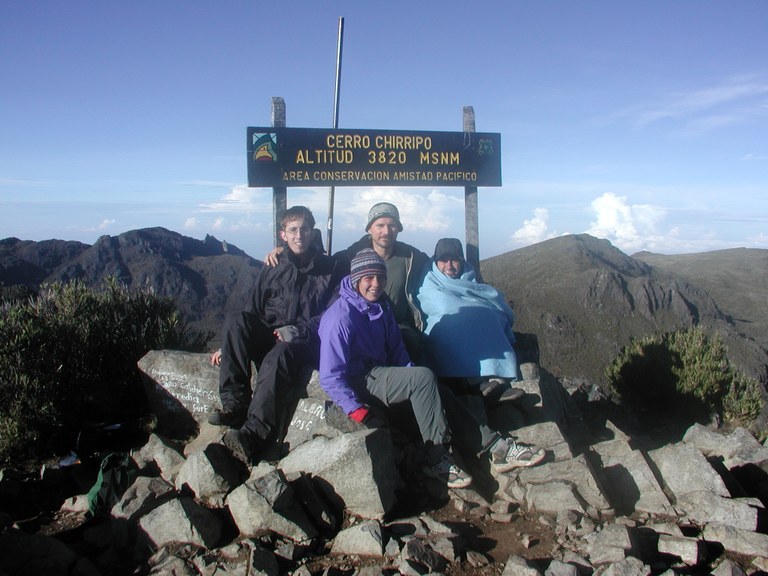 Washington Trails
Association
Washington Trails
Association
Trails for everyone, forever
Luis Villa, Executive Director of Latino Outdoors, reflects how a hike in Costa Rica sparked a new understanding of the connections between social and environmental movements.
Sixteen years ago, I found myself at the halfway point of a hike, catching a glimpse of the Pacific Ocean to one side and the Caribbean Sea to the other. I was atop the highest point in Costa Rica, part of the central American isthmus. A group of friends and I had taken time off from our international volunteer work for the nearly 40-km-long trek in Chirripó National Park over 2 days, up and down a steep trail during weather conditions that spanned from hot and humid to frigid rain and biting cold.

To this day, my hike to and from the summit of Cerro Chirripó is one of my most memorable outdoor adventures. It tested me in a number of ways, certainly physically and emotionally, and was more challenging than expected. It also gave me the opportunity to traverse a number of different ecosystems along a trail with an elevation gain of 7,600 feet from our starting point. I was able to see how the contour of the sloping land, coupled with Costa Rica’s geography as a narrow bridge between two continents, resulted in a variety of biological niches for Chirripó’s flora and fauna and how all that biodiversity was tied together by the area’s watersheds. My hike gave me perspective that went beyond a view of two oceans. The experience was greater than the sum of its parts.
Within 2 years after hiking to the top of Costa Rica, I moved there from California, spending over a decade with Nectandra Institute, a nonprofit dedicated to protecting tropical montane cloud forests. During that time, I met one of my mentors, Álvaro Ugalde, one of the founders of Costa Rica’s system of national parks and protected areas.
I knew Álvaro during the twilight of his life, after his national park service work. He was an engaging storyteller. He would recount how the Costa Rica of his childhood in the 1940s and into the 1950s was known as the country of the barefoot. It was still a highly agrarian society with only a fraction of its current population of 5 million.
Over the next few decades, Costa Rica invested significantly in its public education, health, cultural and other systems of social wellbeing. Some of the cost for this was paid for by abolishing its standing army and redirecting those resources. But these investments also came at an environmental cost: the overexploitation of the country’s old-growth forests.
As more and more Costa Ricans began wearing shoes, going to school and increasing their life expectancy, tree cover nationally dropped from approximately 75% of the land area to 21% between the 1940s and the late 1980s. Vast stretches of pristine tropical forest were cleared to make room for ranching and agroindustrial plantations (with much of the beef, pineapples and bananas being exported to the U.S., which had helped finance much of the deforestation).

Luis’s hike went from hot and humid to cold and wet and offered a close-up view of the diversity of ecosystems in Costa Rica. Photo courtesy of Luis Villa.
However, in the mid-to-late-1960s, Costa Rica began to course-correct, beginning with the creation of its first few national parks. By the mid-2000s, Costa Rica’s forest cover had been restored to more than half of its land area. The people of Costa Rica understood, as I often heard while living there, the importance of the “gallina de los huevos dorados,” their version of the moral of the goose that laid the golden egg.
In 2018, my life’s trail brought me back to the U.S., where I joined Latino Outdoors, an organization dedicated to increasing equitable access to parks, trails, and the outdoors. Over the last two-and-a-half years, I have come to realize that the diversity, equity and inclusion (DEI) efforts that Latino Outdoors is contributing to are actually a part of a much larger movement. It is a movement that also includes organizations such as Washington Trails Association and still others, like Black Lives Matter and Sierra Club, for example.

Cerro Chirripó is the highest point in Costa Rica. Photo courtesy of Luis Villa.
Our connection may not be readily apparent, but we are all traveling on the same trail, one that is meant for everyone. Conservation, environmental stewardship and social justice organizations are all, in effect, working to ensure that resources are more equitably distributed among people and between people and nature. Whether intentional or intuitive, this effort is a course correction. It is a redistribution of capital in its various forms: financial, manufactured, human, cultural and natural.
WTA’s efforts to foster trails for everyone are a part of this. Latino Outdoors’ DEI efforts are a part of this. And dedicated advocates for social justice and the environment are also a part of this, because the power structures and economic systems that are eroding the planet’s stock of natural capital are simultaneously impoverishing communities, dividing people and extinguishing cultures. However, it isn’t enough to unknowingly be a part of this larger movement. We must break out of our silos and fully comprehend why and how it is that we are all on the same trail.
Fundamentally, conservationists and environmentalists are advocates for DEI in the natural world. Fighting for balanced and diverse ecosystems is not much different from advocating for balanced and diverse people systems (social, recreational, cultural, and economic). Seen this way, an alliance between, and perhaps even a fusion of the conservation and environmental and social justice movements is not such a big leap of the imagination and may lead to something greater than the sum of its parts.
The view from the top of Costa Rica was awe inspiring. It provided a perspective of the world that is not easy to come by. But that was only part of the experience. After all, it was an out-and-back trail. My fellow hikers and I did some work to come back down to earth and then continued with the volunteer work that brought us to that part of the world in the first place. I didn’t realize it at the time, but that experience on the trail helped set me on a path that today compels me to look for the bigger picture.
Along with over 750 other organizations, Latino Outdoors and Washington Trails Association are part of the Recreate Responsibly Coalition. The coalition came together earlier this year and is dedicated to promoting safe and responsible outdoor recreation, particularly during these difficult times.
The message of Recreate Responsibly revolves around seven foundational guidelines, one of which is a call to action: Let’s all work together to build an inclusive outdoor community. Part of this work is beginning with the acknowledgment that an inclusive outdoors is not a given; it is a work in progress. In all our other efforts to foster responsible recreation, everything from planning ahead to leaving no trace, it is critical to consciously remind ourselves of the barriers and dangers that many people from marginalized communities continue to face when trying to enjoy the outdoors, is critical. Otherwise, we will continue to be rudely and tragically reminded of it by the despicable acts that continue to happen every day in places like New York City’s Central Park, a tree-lined street in Brunswick, Georgia, or elsewhere in our country.
Latino Outdoors and Washington Trails Association are proud that hundreds of organizations have joined in solidarity and made building an inclusive outdoors a core tenet of the Recreate Responsibly Coalition.
Luis Villa is the executive director of Latino Outdoors, latinooutdoors.org.